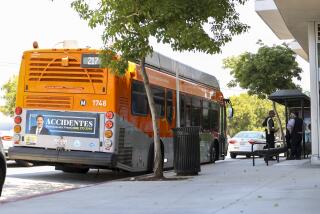Helping Deliver Transit Goods
- Share via
Most of us picture footage of Mel Gibson or Jean-Claude Van Damme parachuting to the rescue when we hear the title “Strike Force.”
And while the transportation problems of the San Fernando Valley are of near epic proportions, it’s going to take something a lot more realistic than a Hollywood ending to solve them.
Enter the San Fernando Valley Transportation Strike Force. Against a backdrop of years of Valley transportation improvement dollars being ripped off, the strike force was formed to ensure that the hard work of Gov. Gray Davis, Assembly Speaker Bob Hertzberg [D-Sherman Oaks] and our legislative delegation has not been in vain.
Since 1980, the Valley has paid more than $2 billion in Propositions A and C sales tax dollars to the Metropolitan Transportation Authority. Yet have any of us noticed an improvement in our daily commute?
In the mid-1990s, a report by the MTA’s inspector general revealed that the Valley had been shortchanged nearly $90 million in improvements promised by state law. As a result, we sit on clogged streets, on backed-up freeways, in crowded buses, in homes waiting for sound walls, and wonder where the next incident of road rage will erupt.
But the Valley’s future can be different. More than $1.7 billion in funding for transportation projects in Los Angeles County has been approved in Sacramento, almost $500 million for the Valley alone. This isn’t pie-in-the-sky transpo-speak or wishful thinking. It’s the real deal. And the projects can make a real difference, but only if they are built.
To get them built, all of us must take a more active role in helping government agencies get the job done and done quickly.
That’s why we have formed the San Fernando Valley Transportation Strike Force, a privately funded, broad-based community organization to help government deliver the goods, quickly, by coordinating communication among cities and agencies, monitoring project progress and reporting back to the public.
The strike force has received the support of Hertzberg, co-chairman of an advisory committee of elected officials. It also is being supported by several major Valley business organizations as well as by its lead sponsor, Washington Mutual, with 3,000 employees at its regional headquarters in Chatsworth.
We are seeking the financial support of other companies and individuals concerned about transportation because we know that oversight and participation make a difference.
The strike force will focus on three broad categories: signal synchronization and operations, transit system improvements, and highway and arterial improvements. Included in these categories are 22 projects totaling nearly $500 million. Taken together, these transportation improvements will significantly increase traffic flow along major streets in the Valley and reduce delays.
*
Among the projects are signal synchronization installations at more than 550 intersections (the largest project like it in the world) from Agoura Hills to Glendale. This system uses state-of-the-art, integrated computer technology to time traffic lights to reflect real-time traffic situations. These improvements will enhance intersection efficiency and improve traffic flow times by as much as 15%.
Also included is an east-west rapid-transit bus system from North Hollywood to Warner Center, a north-south system in the East Valley and miles of sound walls that were promised to residents decades ago.
Added to these projects are improving the San Diego Freeway bottleneck, construction of northbound high-occupancy vehicle (or car-pool) lanes through the Sepulveda Pass, HOV lanes on the Golden State Freeway, improvements to several access ramps on the Golden State and Ventura freeways, and on-ramp beautification projects.
The projects have all been approved. The money has been allocated. Now it’s up to the California Department of Transportation, the MTA and the Los Angeles Department of Transportation to deliver the goods.
The longer the money sits in the state’s general fund, the higher the cost and the greater the chance it could be diverted for the next emergency (such as solving the energy crisis), the next earthquake, flood or whatever. When it comes to the Valley’s money, we use it or we lose it.
Traffic problems are serious and getting worse everyday. Many people have given up, believing that nothing can be done.
We disagree. The strike force intends to make sure that approved projects are built, the money invested and travel times improved. Our message is simple: Just do it!
More to Read
Sign up for Essential California
The most important California stories and recommendations in your inbox every morning.
You may occasionally receive promotional content from the Los Angeles Times.













